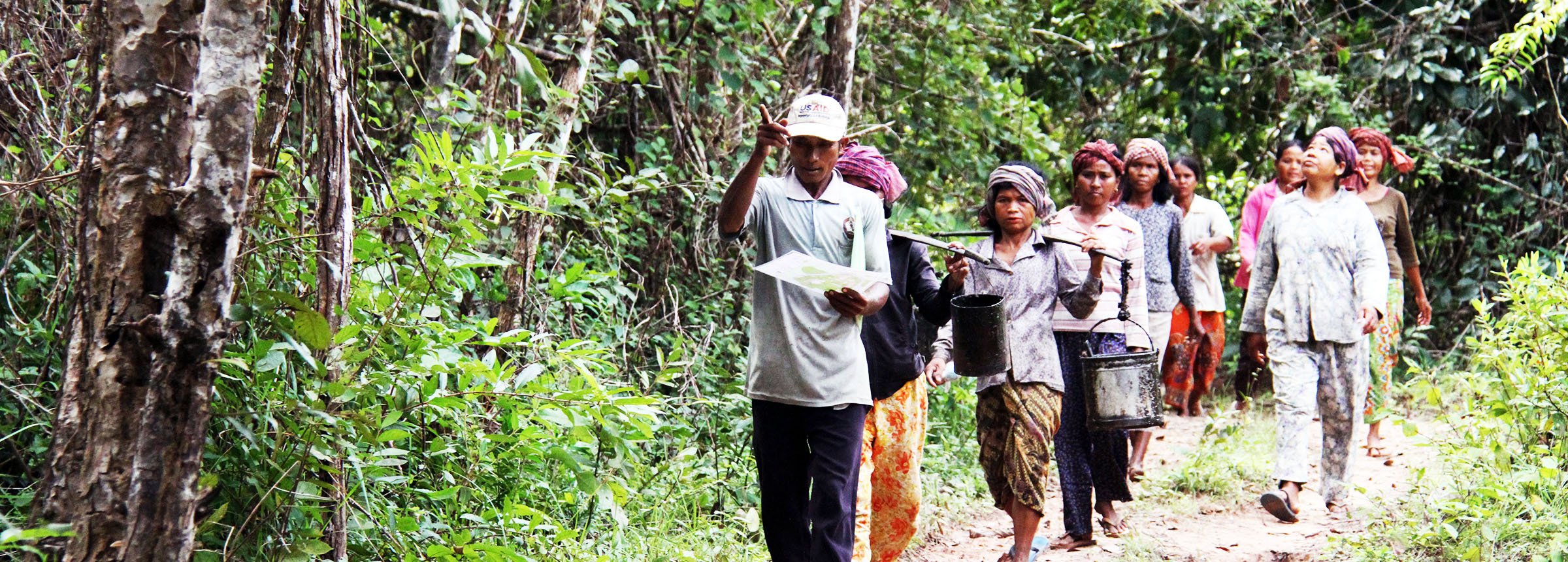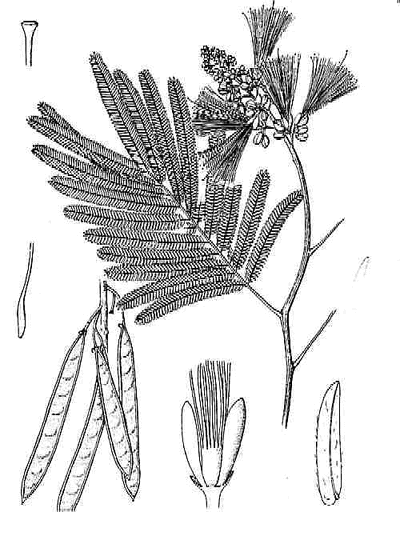
Calliandra calothyrsus — an Indonesian discovery for humid tropical regions
Calliandra calothyrsus is easy to establish and manage, grows quickly, and provides multiple products and services. Intro-duced to Indonesia in 1936 as a shade tree, it proved unsuitable for that purpose, but was adopted by Javanese farmers for fuel-wood production and land reclamation. It has since been planted for green manure, animal fodder, bee forage, and pulpwood. The successful use of C. calothyrsus in Indonesia stimulated global interest in the species, and it is now cultivated for agroforestry throughout the tropics.
 Botany¹
Botany¹
Calliandra calothyrsus Meissner is a small, branching tree growing to a maximum height of 12 m and a maximum basal stem diameter of 20 cm. The stems have red or pale gray bark covered with small, pale, oval lenticels. Toward the tip, the stems tend to be ridged, and in trees with red-brown bark the final stem portion may be tinged with red.
The species has soft leaves divided into many straight leaf-lets. The leaves may reach 20 cm long and 15 cm wide, and they fold against the stem at night. The leaf stalks are ridged with a groove on the upper surface, but they do not have glands between the pairs of secondary axes.
In the species’ native range, flowering occurs throughout the year, but it tends to peak between July and March. The inflores-cences develop at the branch terminals. Several clusters of flow-ers develop around nodes below the axis. The flowers mature over a period of many months, beginning at the base of the in-florescence and progressing to its tip. Each flower opens for a single night to display showy filaments, which usually are white at the very base and red at the tip (although, exception-ally, they may be pink). By the next day, the filaments have wilted, and unfertilized flowers drop.
Pods take from two to four months to develop, and when mature they may be 14 cm long and almost 2 cm wide. They are straight, medium-brown, and contain 8-12 ovules, which may develop into flat, hard, oval seeds up to 8 mm long. In its native range, seed set peaks between November and April. As the pods dry, tensions created in the thickened pod margins cause an explosive splitting from the pod tip to the base that ejects seeds with a spinning motion, dispersing them as much as 10 m away.
The species has several common names in its native range, the most frequently used being “cabello de angel” (meaning “angel’s hair”) and “barbe sol” (“the sun’s beard”). In Indonesia, the species is referred to as “calliandra merah” (“red calliandra”).
Taxonomy¹
Calliandra calothyrsus can be distinguished from species of similar appearance by a unique combination of features. The species’ almost straight leaflets do not tend to overlap, and they do not have a glossy upper surface. The leaves are soft and tend to fold after a branch is cut. The stems, flowers, and pods are almost always glabrous (without hairs). The petals are never thick or woody nor covered in hairs of any length or color.
Ecology and Native Range¹
Calliandra calothyrsus occurs naturally along riverbanks but will rapidly colonize any area of disturbed vegetation (roadsides, for example). It is not particularly tolerant of shade and may soon be out-competed in secondary vegetation. It inhabits a range of sites within Mexico and Central America from sea level to an elevation of 1900 m. It primarily occurs in areas with a mean annual rainfall of between 1000 and 4000 mm, although exceptional populations occur in areas with only 800 mm annual rainfall. It principally occurs in areas with 2-4-month dry seasons (< 50 mm/month rainfall), although it has been found in areas with a dry season as long as 6 months. It occu-pies areas with a mean annual minimum temperature of 18-22°C. It is not frost tolerant. Within its natural distribution, it occurs on a variety of soils and appears to be tolerant of acidic soils with pH values around 4.5. It does not tolerate soils with poor drainage or that are regularly inundated.
Uses
Fodder.² Because of its fast growth and ability to resprout after repeated cutting, calliandra is a useful component of animal pro-duction systems. The edible fraction (leaves, flowers, and twigs) contains 20-25% crude protein, which makes it a good supple-ment for basal diets of grass or other low-quality roughages. The leaves contain high levels of tannin, which may account for its low digestibility of 30-60%. Calliandra should compose no more than 30% of a ration (dry-matter basis). The fodder should be used fresh, because animals respond poorly when it has dried. Small ruminants readily consume calliandra. Cattle may need an adjustment period when this fodder is introduced to their diet. Rabbits and chickens can eat calliandra in small quantities as part of a mixed diet (up to 5% on an as-fed basis). Calliandra is reportedly used as fish feed in Vietnam.
Calliandra may be used in both cut-and-carry and direct grazing systems. For fodder banks, it is often planted at 1 x 1 m, or in hedgerows 2 m apart with trees 50 cm apart within the rows. In either system, planting distances may be adjusted to permit the use of machinery. Depending on the environmental conditions, calliandra may be harvested 4-6 times each year. Trees should be cut again after about 1 m of regrowth. Lopping should not be lower than 30 cm above ground. Under this man-agement, fodder dry matter yields can be 3-8 tons/ha/year.
Wood and pulp.³ Calliandra is widely used as a fuelwood. In Indonesia, over 30,000 hectares of fuelwood plantations are es-tablished on Java alone. The wood has a specific gravity of 0.5-0.8, dries rapidly, and burns well, producing 4600 kcal/kg (7200 kcal/kg as charcoal). It is burned to produce palm sugar, smoke sheet rubber, dry copra, and heat brick and tile ovens. Fuelwood plantations are normally planted at 1 x 1 m or 1 x 2 m spacing. The recommended cutting height is 30-50 cm. An-nual yields are 5-20 m³/ha for one-year-old plantations and 30-65 m³/ha for 20-year-old plantations. With a cellulose con-tent of 44-51%, Calliandra calothyrsus is suitable for paper pulp, but it should comprise no more than 10% of a pulp. In Indonesia, pulpwood plantations are planted at 2 x 2 m spacing.
Agriculture Systems.³ In agriculture systems, calliandra is used to reduce weed growth, conserve soil moisture, and improve soil structure and fertility. It is used as an understory component in coconut plantations, a shade tree in coffee and tea plantations, and a nurse tree in timber plantations. To reduce competition with crops, calliandra is pruned when necessary, commonly 3-4 times a year, to a height of 0.5-1 m. Tree density varies from 160 to 2500 per hectare. Calliandra is also used in hedgerow systems, often on steep slopes, with corn, rice, groundnuts or other crops. Hedges are usually planted 1.5-2 m apart, with trees 1-2.5 m apart within rows. Calliandra calothyrsus is also becoming an important source of forage for honeybees in Indo-nesia.
Reclamation and rehabilitation.³ Calliandra is used to reduce fallow periods and improve soil fertility at densities of 5000-10,000 trees per hectare. It is planted in contour hedge-rows to decrease erosion on steep slopes, with in-row spacing as close as 5 cm. Calliandra has been successfully used to rehabili-tate imperata grasslands in Indonesia. Spacing varies from 1.5 x 1.5 m to 5 x 5 m.
Silviculture
Propagation.4 To achieve rapid and uniform germination, cal-liandra seed (18,000-20,000/kg) should be scarified before sow-ing. For small quantities of seed, the seed coat may be cut or scraped opposite the thin micropyle or hilum and soaked in cool water for 12-24 hours before sowing. For large quantities, soak in cool water for a minimum of 24 hours. Soaking in hot water for 2-5 minutes before the cool-water treatment may increase germination, although hot water may also kill the seed. Careful testing of the chosen technique is recommended.
Seed generally should be sown at a depth equal to its width. Germination should occur in 4-10 days. The choice of nursery container depends on the desired seedling size-for large seedlings, use large containers. Large seedlings compete better and need less care after transplanting. However, small seedlings are easier and less expensive to grow and transport. Seedlings are normally ready for field planting after 6-12 weeks in the nursery when 15-50 cm tall. Standard nursery management and seedling hardening-off procedures should be followed.
Calliandra may be established by directly sowing scarified seed at the planting site. Sowing should be done at the begin-ning of the rainy season. Stump sprouts of 4-12-month-old seedlings, or vegetative cuttings from succulent stems or roots (cultivated in propagation boxes), can also be used to produce suitable planting material. All calliandra planting material is susceptible to early competition. Intensive weed control should be practiced until calliandra is well established, particularly in grass ecosystems.
Seed production and collection.5 Compared to other legumi-nous tree species, calliandra is known to be a “shy” seed pro-ducer outside its native range. One reason for this is that the primary pollinator-bats-may require a few years to identify new stands of calliandra as feed resources. Trees flower through-out the year but have a peak flowering period 3 months before the dry season. Individual flowers are receptive to pollination for only one night. Individual trees may produce receptive flowers over a 4-6 week period. Demand for high-quality calliandra seed is growing and exceeds supply. The Oxford Forestry Institute is currently working on seed orchard guidelines.
Calliandra seed is sensitive to improper handling—only fully mature seed should be collected, before pods open. Dried seed can be stored in air-tight containers at 4ºC for up to 5 years. Bulk seed should be stored in sacks in a shaded, cool, dry area, protected from insects, rats, and mice.
Symbiosis.4 Calliandra root systems form symbiotic relation-ships with both Rhizobium bacteria and vesicular-arbuscular mychorrhizal fungi (VAM).
Pests and Diseases.6 Information is available on pests and dis-eases of the genus Calliandra, but there has been little system-atic study of pests or diseases of C. calothyrsus. However, it does not appear to suffer serious damage from pests or diseases in its native range or in areas where it has been introduced.
References
All references are from Powell (1997).
Powell, M. (ed), Calliandra calothyrsus production and use: a field manual. FACT Net, Winrock International, Morrilton, Arkansas, USA.; the Taiwan Forestry Research Institute; and the Council of Agriculture, Taipei, Taiwan, Republic of China.
1Macqueen, D. Botany and ecology. p. 1-10.
2Paterson, R., B. Palmer, M. Shelton, R. Merkel, T.M. Ibrahim, R. Arias, K. Berhe and A.N.F. Perera. Fodder production. p. 29-34.
3Ty, H.X., E. Hernawan, M. de S. Liyanage, M. Sila, H. Ramdan, A.N. Gintings, K. Hidayat, A. Setijoprodjo, R. Roothaert, R. Arias and D. Macqueen. Uses. p. 23-29.
4Roshetko, J.M., D. Lesueur, and J.M. Sarrailh. Establishment. p. 11-22.
5Chamberlain, J.R., A.J. Pottinger, and R. Rajaselvam. Seed collection and production. p. 7-10.
6Boa, E. 1997. Pests and diseases. p. 35-44.
A full set of references is available from FACT Net
Prepared by FACT Net staff, Winrock International
A publication of the Forest, Farm, & Community Tree Network (FACT Net) (formerly the Nitrogen Fixing Tree Association)
